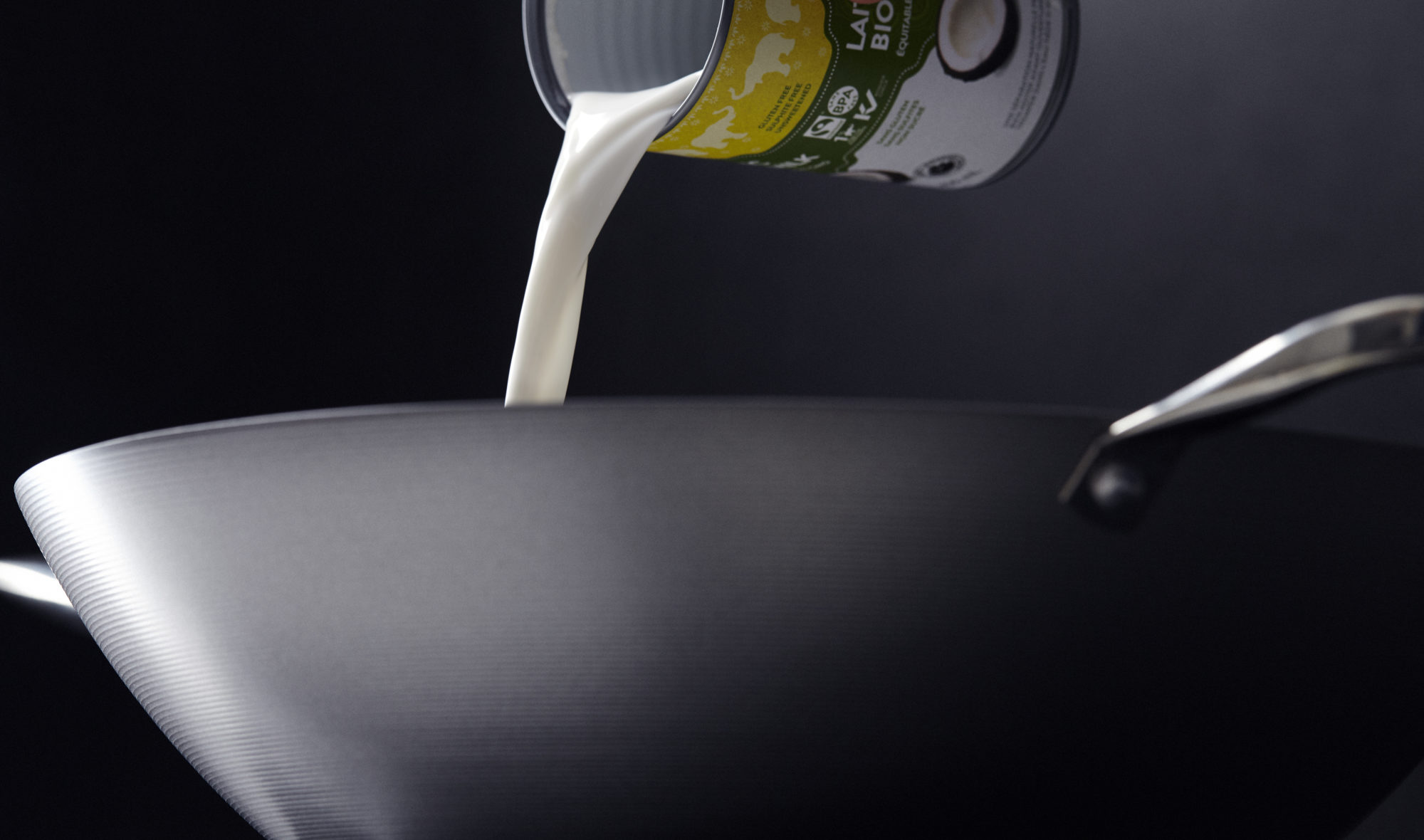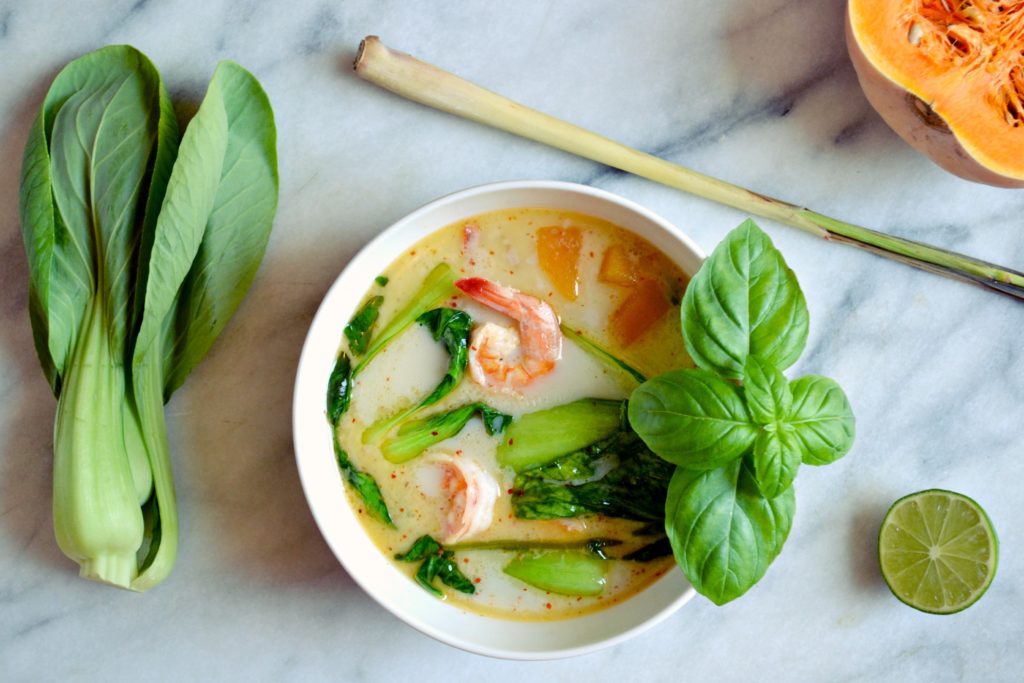Coconut Milk


Coconut milk is a creamy liquid made from grated coconut flesh and water. Common in southeast Asian cuisine, it works well in savory and sweet dishes ranging from curries and soups to puddings and baked goods. High in saturated fat, coconut milk also offers plenty of vitamins and minerals including iron and manganese. While coconut milk can be made from scratch at home, it’s more convenient form is canned. (Don’t confuse true coconut milk with refrigerated beverages meant as dairy substitutes - these are something different.) Check the ingredients - ideally, the can will contain nothing but coconut milk and water. Coconut milk can be used straight out of the can or gently cooked.
Coconut milk is the liquid expressed from grated coconut flesh and water.
True coconut milk may be purchased in a can or occasionally in a shelf-stable carton, or you can make it from scratch by pureeing desiccated coconut with water.
Note that this coconut milk is different from refrigerated coconut milk beverages – the kind you find in cartons in the dairy case. Such coconut milk beverages usually contain more water and sometimes other additives and sweeteners; they are meant to be treated as milk alternatives rather than ingredients for cooking.
Coconut milk is also different from coconut water, which is the watery substance contained in a coconut. (Once again, beverages labeled coconut water may also have other ingredients and sweeteners added to them.)
If a recipe calls for coconut milk, look for the kind in a can. Ingredients should include coconut milk, water, and possibly a stabilizer such as guar gum – nothing more.
Coconut milk has a rich, unctuous flavor and texture that works well in sweet or savory preparations. It’s a staple of Southeast Asian cuisine (think Thai curries, soups, and coconut sticky rice). But it’s a versatile ingredient that can be used in all kinds of ways: baked goods, broths, drinks, sauces, marinades, puddings, dairy substitutes, and more.
Coconut milk is white and has a smooth, silky texture. It could easily be mistaken for milk or cream. If in doubt, a sniff or taste will give it away: it smells and tastes distinctly of coconut.
One half-cup of canned coconut milk contains approx 223 calories, 2.3g of protein, 24.1g of fat, and 3.2 grams of carbohydrates.
It’s worth noting that coconut milk is very high in saturated fat. It also contains numerous vitamins and minerals, including iron, magnesium, phosphorus, potassium, copper, selenium, and vitamin C. Coconut milk is a particularly good source of manganese: one cup of coconut milk surpasses your daily requirements.
When purchasing coconut milk, make sure to differentiate from coconut water, coconut cream, and coconut milk beverages.
Cans of coconut milk are often found in the Asian or International section of your supermarket. You may also find them at an Asian grocery store.
When choosing coconut milk, shake the can: if you can hear liquid shaking about inside, this is a sign that more water has been added to the product. Ideally, the inside liquid should be thick and dense.
You may find “light” or “lite” coconut milk options. These types will usually have lower calories but it will also likely have more water added. The flavor and texture will be slightly different, so consider your recipe before choosing.
Before buying, check the ingredients on the can. Ideally, the can will contain only coconut and water. Some brands also add preservatives, emulsifiers or stabilizers; aim to select coconut milk with as few additives as possible. (Hint: if you want to know exactly what’s going into your coconut milk, you can try making your own. To do so, look for high-quality desiccated coconut with no added sweeteners.)
Once open, pour any extra coconut milk into an airtight container and refrigerate for up to three days.
A can of coconut milk can be stored in your pantry and used anytime before the expiry date.
Inside the can, the coconut cream rises to the top. For most recipes, you will want to shake the can before using to thoroughly blend the fat throughout the milk. (In some cases a recipe will ask you to remove and/or reserve the coconut cream; in this case do not shake the can — open it gently and remove the top layer of fat with a spoon.)
Canned coconut milk requires very little preparation. You can consume it straight out of the can if you like.
If making a curry, toast your spices and/or curry paste and aromatics in a pan first. Add coconut milk after other ingredients have been cooked; slowly simmer it to bring the flavors together. Don’t boil coconut milk – if the temperature is too high for too long, the milk will curdle.
While curries are a common (and wonderful) use for coconut milk, there are many more options available. For example, try using coconut milk in a seafood broth, in a marinade for chicken, in a braise for beef, or in a chickpea and vegetable stew.
Coconut milk can be used to make sweet sticky rice, tapioca pudding, coconut ice cream, and more. (Some people even put it in their coffee.)
And for breakfast, consider adding a splash of coconut milk to your smoothie, drizzle a little over your yogurt or oatmeal, or make a chia seed pudding for a luscious breakfast treat.

Highly aromatic and layered, this satisfying chunky Thai lemongrass soup is a complete meal full of color, flavor, and nutrition.
Prep Time: 15 minutes Cook Time: 25 minutes Yield: 4 servings
In a medium to large pot, add the coconut milk, water, fish sauce, honey, salt, red pepper flakes, ginger, and lemongrass, and whisk together. Bring to a simmer over medium heat.
Once your stock is simmering, add the cubed butternut squash. Continue simmering for 10-15 minutes, until the squash is tender but still firm.
While your squash is simmering, in a separate pan, cook your shrimp: Season pan with a teaspoon of oil and cook your shrimp just until they curl up and turn orange. Sprinkle with salt. Set aside.
Once your squash is cooked, turn off the heat but keep the pot on the burner, and add the bok choy, basil, cooked shrimp, and the juice of one lime. Stir and let the soup sit for a few minutes until the greens turn bright green and wilt slightly. At this point, your soup is ready to serve!
*Note: It’s your choice when to remove the lemongrass. You can remove it before serving, or you can let your dinner guests have fun fishing out large lemongrass pieces like a treasure hunt. Lemongrass isn’t inedible, it’s just very tough and fibrous.
Precision Nutrition’s Encyclopedia of Food expands every single month as we highlight new foods and showcase beautiful food photography. If you’d like to stay up to date, simply click this link. From there, we’ll send you a FREE copy of our recipe book. We’ll also let you know when new and delicious foods are added to the site.
Coconut milk is a creamy liquid made from grated coconut flesh and water. Common in southeast Asian cuisine, it works well in savory and sweet dishes ranging from curries and soups to puddings and baked goods. High in saturated fat, coconut milk also offers plenty of vitamins and minerals including iron and manganese. While coconut milk can be made from scratch at home, it’s more convenient form is canned. (Don’t confuse true coconut milk with refrigerated beverages meant as dairy substitutes - these are something different.) Check the ingredients - ideally, the can will contain nothing but coconut milk and water. Coconut milk can be used straight out of the can or gently cooked.